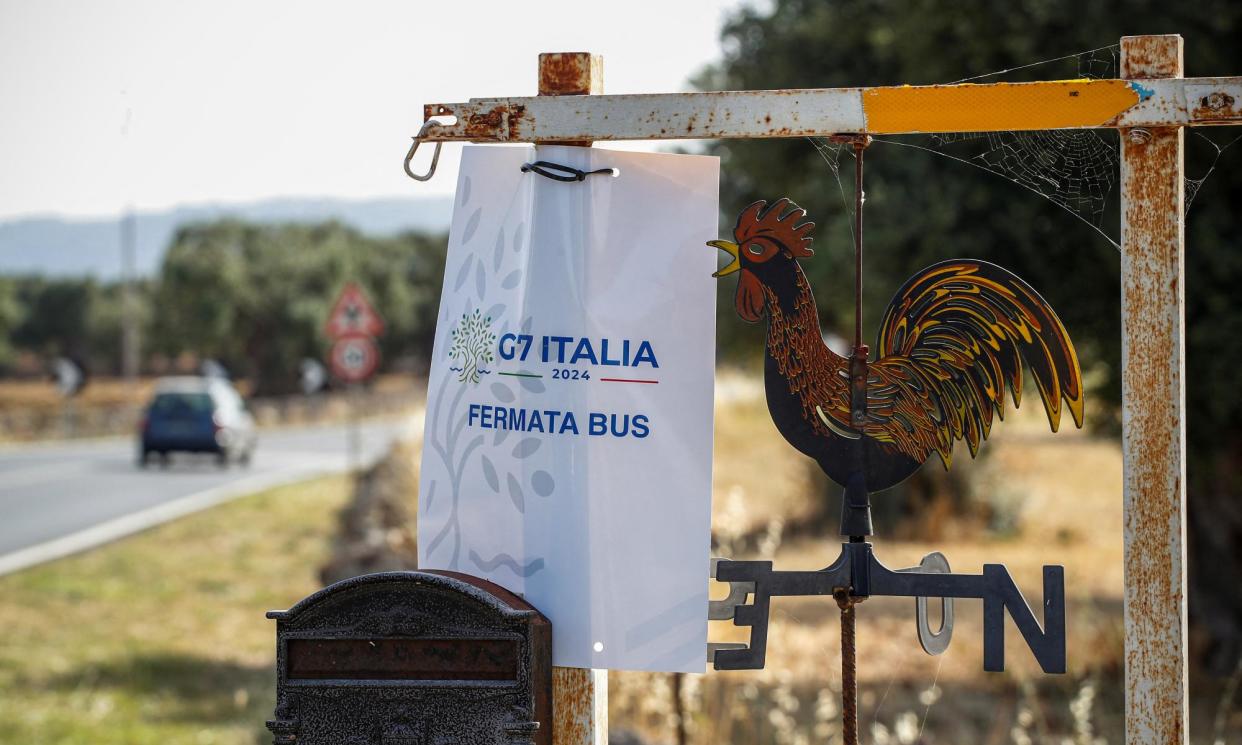G7 leaders head to Italy for summit as Ukraine and Russia top the agenda

A dramatic expansion of entities exposed to US sanctions for helping the Russian economy and an EU-led $50bn loan to ease the financial burden on Ukraine will be at the centre of discussions at a summit of the leaders of wealthy G7 nations in Puglia, Italy, starting on Thursday.
The leaders, facing unprecedented challenges from discontented electorates, will be under heightened pressure to provide concrete results as their three days of discussion range across an interlinked agenda encompassing the war in Ukraine, migration, Africa, the Middle East, the climate crisis and harnessing artificial intelligence (AI).
The G7 was once a cloistering of western leaders in informal conversation, but host countries can invite outside guests to join some of the sessions. Italy has thrown open the doors and will welcome Pope Francis; Javier Milei, the populist president of Argentina; Narendra Modi, the Indian prime minister; and Luiz Inácio Lula da Silva, the Brazilian president. Ukraine’s president, Volodymyr Zelenskiy, will stage a joint press conference with the US president, Joe Biden. The aim is to show the west remains determined to confront Russia’s “arsenal of autocracy”, but is not preoccupied with its own problems.
The meeting is also billed by the US state department as the best opportunity to ease Ukraine’s financial burdens before the US’s presidential elections in November and send a message to Russia of western stamina. As much as feasible the G7 would like its decisions to be Trump-proof.
Underlining the urgency of the challenge, at least nine people were killed in a Russian missile strike on apartment block in Zelenskiy’s home town, Kryvyi Rih. Twenty-nine others, including five children, were wounded in the attack on Wednesday.
The key US initiative – announced on the eve of the summit – is a large expansion of entities, including banks, that will be subject to sanctions if they are deemed to be enabling not just Russia’s military industrial complex, but any sanctioned Russian entity. This secondary sanction regime, already deployed by the US in Iran and applied in December to entities helping the Russian military, will mean many more non-US citizens and banks will be vulnerable to the sanctions, particularly if they trade in dollars. On one estimate the number of entities with which no one should trade will rise from about 1,000 to 4,000.
The shift, justified by the US on the basis that the entire Russian economy is now part of its war economy, is designed to have a chilling effect on the network of states in the Balkans, the Middle East and central Asia that act as conduits for western exports that are then sold on to Russia. For example, exports of German-produced cars to Kyrgyzstan have boomed by 5,000% in one year.
The US treasury secretary, Janet Yellen, said on Wednesday: “We are increasing the risk for financial institutions dealing with Russia’s war economy and eliminating paths for evasion, and diminishing Russia’s ability to benefit from access to foreign technology, equipment, software, and IT services.”
The plan has largely been advocated by Daleep Singh, the original US architect of the first round of post-invasion sanctions in 2022, who has returned to the state department after a spell in the private sector. Singh, the deputy national security adviser for international economics, said at a recent Brookings Institution event that the sanctions regime was impactful, but added: “We have to match every circumvention with a countermeasure”.
A frequent criticism of the G7 is the lack of continuity between one country’s annual chairship and the next, but economic aid to Ukraine has become one of the few policy areas where the group, through a little-known network of subgroups, has formed a near-permanent bureaucracy.
There are two contentious decisions concerning Ukraine at the summit. The first is highly technical. The second is political.
The first centres on whether, as the US wishes, the annual profits derived from frozen Russian central bank state assets frozen by the G7 in 2022 and worth approximately $281bn could be mobilised to service the interest on a $50bn loan to Ukraine. The second concerns how far to try to punish China for its support for the Russian economy.
France and Britain had backed the US scheme, but the EU – where the bulk of Russia’s assets are stored – said the US plan was dependent on the bloc agreeing to renew the retention of the profits every six months, a decision that requires unanimity among the 27 member states, a guarantee it could not give. The level of detail provided at the summit about an alternative EU scheme designed to secure the same loan will be a test of its credibility.
Advocates remain for handing the entirety of the assets to Ukraine as compensation for Russian war damage, but the plan does not yet have the necessary political support. David Cameron, the UK’s foreign secretary, this week conceded that complete seizure is a non-starter.
On Wednesday the US national security adviser Jake Sullivan said of the loan proposal: “We are moving to a common understanding of the mechanism and we expect participation of multiple countries.”
The second issue focuses on China’s role in selling machine tools, semiconductors, and other dual-use items to Russia so it can rebuild its industrial base.
Josep Borrell, the EU foreign affairs chief, acknowledged that “China has committed not to supply arms and we don’t have evidence that this has happened”. But he said the phrase dual-use means no clear separation existed between arms and non-arms and that Chinese exports to Russia had risen by more in the last two years than in the previous 10.
Much will depend on how far China is prepared to risk trade relations with the US to support Russia. Singh said the difficulty for Russia is that “the partnership without limits” hailed by Putin is a “partnership without symmetry”, leaving Russia strictly the supplicant.


